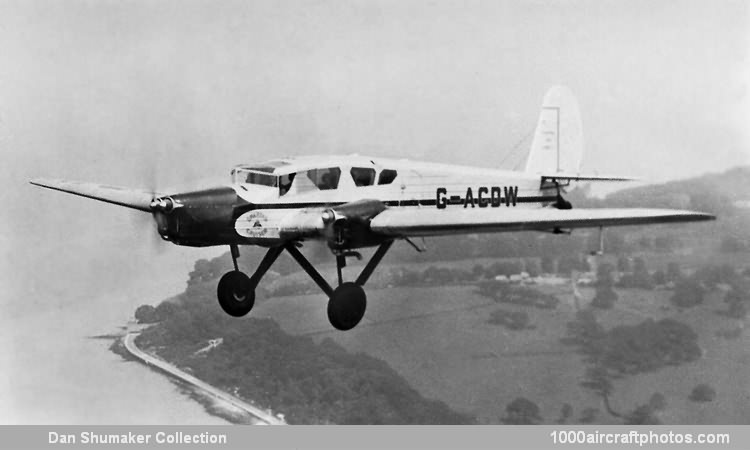02/28/2014. Remarks by Johan Visschedijk: "The hard-worked Spartan Cruiser of the 1930s stemmed from the Mailplane. Although the pure mail carrier had no future, the design held promise for passenger work, team effort at East Cowes being rewarded by successful trials of the Cruiser Mk.I, G-ABTY (c/n 24M), by L.A. Strange in May 1932.
The low-wing tri-motor layout had been retained, but an all-metal fuselage had been built to accommodate six passengers and two crew. The structural features of the stressed-skin hull and plywood-covered wing of the Cutty Sark, had been adapted for the Cruiser, which also used cabin glazing reminiscent of the Saunders-Roe Segrave Meteor. Power plants were three 120 hp de Havilland Gipsy III four-cylinder air-cooled inverted piston engine.
The new machine was demonstrated at the first Hendon SBAC Show of June 27, 1932, and alongside its predecessor, the Mailplane, at the Spartan demonstration at Heston on August 30. Piloted by Strange, it left on October 14 for a European sales tour. On its return to Heston on the 25th, 3,593 mls (5,782 km) had been covered at an average speed of 113 mph (182 kmh).
The first Cruiser Mk.II, flown in February 1933, was ordered by Iraq Airwork Ltd. for an experimental air route between Baghdad and Mosui, and although initially registered G-ACBM (c/n 2), was flown out in Airwork white and green as YI-AAA by T. Neville Stack. It was powered by three 130 hp Cirrus Hermes IV four-cylinders air-cooled in-line engines and entered by a cabin door instead of via folding side and roof panels, while the pilot's windscreen was V-shaped for improved vision.
During the next two years, eleven more Cruiser Mk.IIs were built, five of which, fruits of the overseas sales tours, were sold abroad. Two, G-ACJO (c/n 5) and G-ACMW (c/n 6), were flown to Belgrade on delivery to the Yugoslav airline Aeroput (they became YU-SAN and YU-SAO respectively), and two, G-ACNO (c/n 8) and G-ACOU (c/n 9), to the Bata Shoe Company at Zlín, Czechoslovakia (they became OK-ATQ and OK-ATM). In May-June 1934 OK-ATQ, named 'Cape of Good Hope', carried out a successful 21,900 mls (35,245 km) business trip of Europe, the Near East, Egypt, Sudan and South Africa.
For the fifth exported Cruiser (c/n 7), the registration G-ACKG was reserved but not taken up, as it was shipped to the Maharajah of Patiala in November 1933, being registered in India as VT-AER. The majority of the Cruisers were powered by 130 hp de Havilland Gipsy Major four-cylinder air-cooled inverted in-line engines, but G-ACOU had 130 hp Walter Major 4 four-cylinder in-line engines and the Indian was fitted with Hermes IVs.
An operating company known as Spartan Air Lines Ltd., formed to open an internal air route between Heston and Cowes, began operations on April 1, 1933, with the Cruiser Mk.I and two new Cruiser Mk.IIs, G-ACDW (c/n 3) and G-ACDX (c/n 4). The firm's chief pilot, P.W. Lynch Blosse, flew G-ACDW, specially named 'Faithful City', to Australia and back at the end of the season, on charter to Captain W.P. Crawford Green and Lord Apsley. Leaving on October 9, 1933, Sydney was reached on the 30th, and the machine eventually arrived home to make a precautionary landing on St. Osyth beach, Essex.
The Southern Railway then acquired a controlling interest in Spartan Air Lines and the London terminus was transferred to Croydon on May 1, 1934. Two new Cruiser Mk.IIs, G-ACSM (c/n 10) and G-ACVT (c/n 11), were then commissioned together with G-ACBM, back from Iraq to replace G-ACDW, which had left Heston as SU-ABL on delivery to Misr Airwork Ltd., at Almaza, Cairo, in April.
They were joined in the following year by the final Cruiser Mk.II, G-ACZM (c/n 14), built to replace the Cruiser Mk.I, sold to Victor Bruce in February 1935. It was then employed on charter work by Channel Air Lines, mainly on the early morning newspaper run to Le Bourget, until it forced landed in the Channel and was lost a few months later. The penultimate Cruiser Mk.II, G-ACYL (c/n 12), built for United Airways Ltd., operated the company's service between Heston, Stanley Park and Ronaldsway throughout 1935.
Cruiser production finally ended in May 1935 with the delivery to Spartan Air Lines of the three Cruiser Mk.III, of similar design to the Mk.II but with aerodynamically refined fuselage, modified windscreen, empennage and trousered landing gear while passenger accommodation was increased to eight. The prototype, G-ACYK (c/n 101), made its public debut at the Heathrow Garden Party of the Royal Aeronautical Society on May 5, 1935, soon thereafter G-ADEL (c/n 102) and G-ADEM (c/n103) were delivered.
The year 1936 saw the absorption of Spartan Air Lines by British Airways Ltd., and the transference of the surviving Cruisers to a new base at Eastleigh, from which they worked over the Isle of Wight, Heston, Blackpool, Isle of Man network. The Cruiser Mk.IIIs carried Railway Air Services Ltd.'s livery during the season, but G-ADEM was burned out at Stanley Park in the November and Captain O'Connell and a passenger killed through flying into a hangar when taking off in fog.
The four surviving Cruisers were then taken over by Northern and Scottish Airways Ltd., Renfrew, continuing in service to the Highlands and Islands until the outbreak of war. From June 1938 they did so under Scottish Airways ownership, three being impressed by the RAF in April 1940: G-ACSM as X9433, G-ACYL as X9431 and G-ADEL as X9432."
